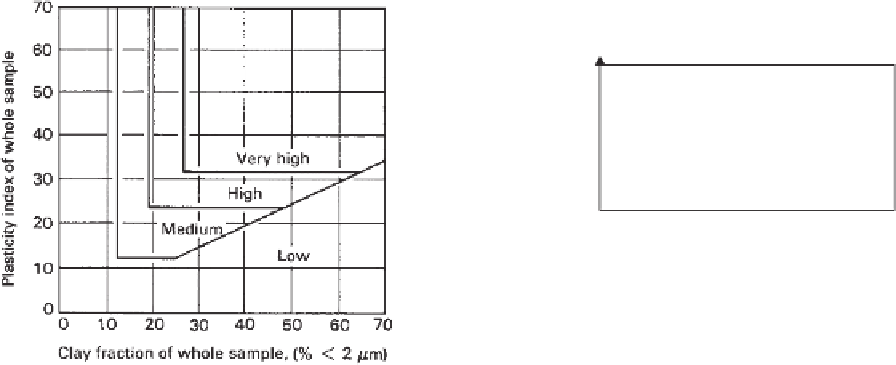Environmental Engineering Reference
In-Depth Information
Token
load
Field
behavior
In situ
stress state
e
0
Sampled soil
Applied load,
σ
Laboratory measurement
(a)
Figure 14.2
Correlation between soil classification properties and
swelling potential (after van der Merwe, 1964).
Reload (lab)
manner in which the relationship between overall volumet-
ric strain and soil suction are defined. The prediction of
heave on the basis of measured matric suction values has
not been extensively used in geotechnical engineering prac-
tice. The use of a direct approach to predicting total heave
has been limited because of difficulties in measuring in situ
matric suction and corresponding stress path soil proper-
ties. In some cases, measurements of total suction have been
used in place of matric suction measurements; however, this
methodology has also experienced limited success due to
lack of accuracy.
The methods for heave prediction based on one-
dimensional oedometer test results still appear to be the
most common in engineering practice. Total heave is
usually calculated for the case where matric suctions are
released to zero. Overall volume change is computed in
terms of changes in (equivalent) total stresses when using
oedometer methods. The direct measurement of matric
suction is not required when using the (equivalent) total
stress change approach. There are several one-dimensional
oedometer-based testing and analysis procedures that have
been proposed over the years. Some of these procedures
are listed below along with an interpretation of the actual
stress path that is being followed in each case.
Sampling
In situ stress
state
Matric suction
(
u
a
-
u
w
)
(b)
Figure 14.3
Stress path followed when using direct model
method: (a) two-dimensional plot showing stress path followed
in field and laboratory; (b) three-dimensional plot showing stress
path followed.
in Fig. 14.3a. The underestimation of the amount of heave
appears to be primarily due to a lack of consideration of
the effects of disturbance experienced by the soil during
sampling.
The Sullivan and McClelland method is based on a
“constant-volume” oedometer test on an undisturbed sample
initially subjected to the overburden pressure. Once the
applied load equals the ability of the soil to undergo any
further swelling, the sample is loaded and unloaded. The
stress path followed in the Sullivan and McClelland method
is shown in Fig. 14.4. The availability of published case
histories where this method has been used is limited. It
is anticipated that this method would likely underestimate
actual heave since sampling disturbance has not been taken
into consideration.
The “double-oedometer” method is based on the results
of two oedometer tests: a “free-swell” oedometer test and a
“natural water content” oedometer test. Specimens are ini-
tially subjected to a token load of 1 kPa. No water is added
to the oedometer pot during the natural water content test.
The natural water content oedometer test data are adjusted
14.3.2 Oedometer-Based Methods of Testing
Expansive Soils
The “direct model” method is based on a “free-swell”
oedometer test on undisturbed samples (Fig. 14.3).
Specimens are subjected to the overburden pressure (or the
load that will exist at the end of construction) and allowed
free access to water. The predicted heave is generally
significantly below the actual heave experienced in the field
if the soils are wetted. The stress path followed when using
this test procedure is shown in Fig. 14.3b. The conventional
two-dimensional manner for plotting the test data is shown


























Search WWH ::

Custom Search